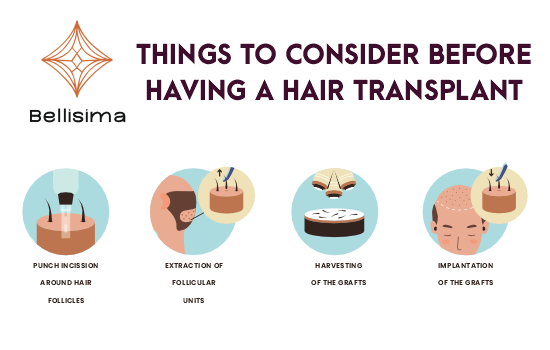Many patients now seek hair transplants to restore full head hair because of technological advancements and highly trained doctors. The outcomes might change your life by making you seem younger and possibly even increasing your self-confidence. However, it might be challenging to select the best hair transplant method for you. Both FUE and FUT are successful hair transplant procedures with durable results, so there are several factors to take into account when deciding which is best for you.
To help you decide which hair transplant method would be ideal for you, we have compared and contrasted the FUE and FUT methods in this post. We’ll examine the features, comparisons, and benefits and drawbacks of each method.
How Does Hair Transplant Work?
When it comes to treating hair loss, hair transplants are far more effective than other non-surgical options like over-the-counter medications. Within four months, patients may anticipate that between 10% and 80% of their transplanted hair will fully regrow; it’s crucial to note, though, that the transplanted hair will eventually thin down much like natural hair.
Although most hair transplants are successful, there is no certainty that a transplant will be successful; the patient has a major role in the procedure’s outcome. People who have dormant hair follicles, baldness and more extensive thinning/baldness, hair loss from chemotherapy, and extremely thick scalp scars may have less favourable transplant outcomes.
What is FUE & FUT?
- FUE (Follicular Unit Extraction)
The hair transplant procedure known as Follicular Unit Extraction (FUE) has become more prevalent than the conventional Follicular Unit Transplantation (FUT) approach. Whereas a strip of tissue is removed during FUT, individual follicular units are collected from the scalp during FUE.
The scalp is shaved during a FUE surgery, and each follicular unit transplant is removed separately. Using a motorised surgical instrument, tiny circular incisions are made on the scalp, usually with a punch size of 0.8 to 1 mm.
Unlike a FUT, which can leave a conspicuous scar at the donor spot, it enables the surgeon of FUE Hair Transplant in Ahmedabad to harvest hair from the donor area without leaving a linear scar.
Compared to the linear scar from FUT, the sequence of small dot scars left on the scalp by the extraction of follicular units with FUE are less noticeable. This is especially true when hair grows back and covers the dot scars, which tend to be less obvious.
The extraction of follicular units may cause the donor region to gradually thin down if several sessions are needed.
However, given the amount of hair that is accessible in the donor site, it is imperative to guarantee a sufficient supply of donors for a long-term strategy.
- FUT (Follicular Unit Transplantation)
A strip of the patient’s scalp is extracted from the back of the head during follicular unit transplantation (FUT), and the incision is stitched up. The surgeon will next use a knife to cut the strip of scalp into smaller pieces in order to isolate the hair follicles. Grafts are the smallest segments. Sometimes, however, a surgeon would divide the original scalp strip into thousands of grafts, each of which will have one to four hair follicles.
Next, the surgeon will create tiny holes on the scalp where the grafts are to be implanted using a needle or blade under a microscope. Following the insertion of grafts into these holes at the donor site, bandages or gauze are used to cover the surgical site. Local anaesthetic is used during the entire process.
Advantages of FUE
- No linear scar
The fact that FUE leaves the donor area of the scalp without a linear scar is one of its many noteworthy benefits. Rather, discrete follicular units are removed with microscopic punches, resulting in scarcely perceptible, round scars.
- Wearability of Short Hair
Hair may be worn short using FUE without running the risk of leaving a noticeable linear scar. People who like shorter haircuts or who have a professional need to have a tidy look may find it very helpful.
Disadvantages of FUE
- Shaving Necessity
Shaving the back and sides of the head is required for a conventional FUE operation in order to make the extraction of individual follicular units easier. Those who would rather retain their hair long or who don’t want to disclose the transplant operation may find it concerning.
As an alternative, some clinics provide Long Hair FUE, which enables the extraction without shaving but may come at an extra expense.
- Expensive
FUE hair transplant treatments are more expensive than FUT. Higher expenses for FUE procedures are frequently the result of the painstaking nature of the unique extraction process, as well as the sophisticated expertise and time needed.
Advantages of FUT
- Sufficient Time for Recovery
A FUT operation often has a fairly manageable recovery period of 10–12 days. Because there may be swelling where the scalp strip was removed, some patients have found FUT to be more uncomfortable than other treatments. Painkillers are prescribed in these cases.
- Increased Follice Survival Rate
Hair from the mid-donor zone, where the majority of the hair is permanent, is extracted for FUT. Patients with low hair supply in the donor site are therefore frequently advised to undergo FUT therapy. FUT allows for the meticulous harvesting of follicles while maintaining the protective tissue, resulting in stronger, higher-quality grafts.
Disadvantages of FUT
- The linear scar left behind from the surgery is the biggest disadvantage of FUT. Particularly if the hair is shaved or extremely short, the donor’s hair strip removal leaves a noticeable scar behind.
- Even though the mark may be covered up by longer hair, those who like shorter hair or who want to maintain their hair shorter may find it concerning.
- It might not be able to maintain the back of the hair extremely short because to the linear scar caused by FUT. Some people may find that their options for hairstyles are limited since the scar may be visible at these shorter lengths.
- Compared to FUE, some patients may feel more pain or discomfort at night after FUT. But how each individual perceives pain is subjective and might differ.
- Although significant postoperative pain is not experienced by everyone, it is a risk that has to be considered when selecting the transplantation technique.
Difference Between FUE Vs FUT Hair transplant
The technique used to remove hair is the main difference between a FUE Vs FUT hair transplant. A strip of hair is taken from the back of the head during FUT, creating a linear scar; in contrast, individual follicular units are extracted and transplanted with FUE, leaving much less scarring. As opposed to a linear scar from FUT, a FUE scar really looks like a tiny dot. Because of this, some FUT hair transplant patients might decide to grow their hair longer in order to hide the scar.
1. Recovery
Recovery times are usually longer with the FUT technique because it requires a more intrusive process that takes hair grafts as a strip of scalp instead of individual follicles. While FUE hair transplant recovery takes about five to seven days, FUT patients may need to wait ten to fifteen days before they can resume their regular activities. In addition, recipients of FUT hair transplants should take extra care with the stitches at the donor site.
2. Cost
In most clinics of hair transplant cost in Ahmedabad, you may anticipate paying more for the more advanced FUE procedure than the more traditional FUT approach. The cost will also depend on how much work has to be done. FUT hair transplants are less expensive because they can be completed more quickly than FUE hair transplants, which are more complex and need more time. Individuals who find themselves in need of more grafts could discover that FUT helps them stick to their budget.
3. Success Rate
It might be difficult to determine which approach has higher success rates because the results of hair transplants rely on a number of variables, including:
- The age of the patient
- Area and extent of hair loss
- Amount and quality of hair donated
- Skills and experience of surgeons
However, research indicates comparable success rates for FUE and FUT. With outcomes that seem natural, both methods may produce hair growth and density at comparable rates. Selecting a knowledgeable and competent surgeon and adhering to the aftercare instructions are ultimately what determine whether a FUE or FUT hair transplant is successful.
4. Results
Both FUE and FUT procedures are capable of producing acceptable outcomes. However, because the FUT procedure usually yields more hair to transplant, it can produce superior results if a substantial volume of grafting is needed. On the other hand, a FUE hair transplant causes less noticeable scarring than a FUT hair transplant because of the nature of the grafting procedure, which removes hair follicles with small punches as opposed to from a strip.
Which Type of Hair Transplant is best for you?
Many considerations, which will be covered in your appointment with your surgeon, will determine whether you opt for a FUE Vs FUT Hair transplant. A FUT operation is sometimes a better option for those who need more hair grafts because of more severe hair loss, as FUT grafts often provide a higher number of follicles for transplanting.
On the other hand, because FUE procedures are less intrusive, patients may recover more quickly from them and are thus a preferable option for people who just need a few grafts or who want to resume their regular activities soon after receiving a transplant.
In order to decide which treatment is best for your transplant needs, hair transplant in Ahmedabad will confer with you. This will entail evaluating the quantity of donor hair that is available, the quality of the donor’s hair, and the number of grafts that are required.




